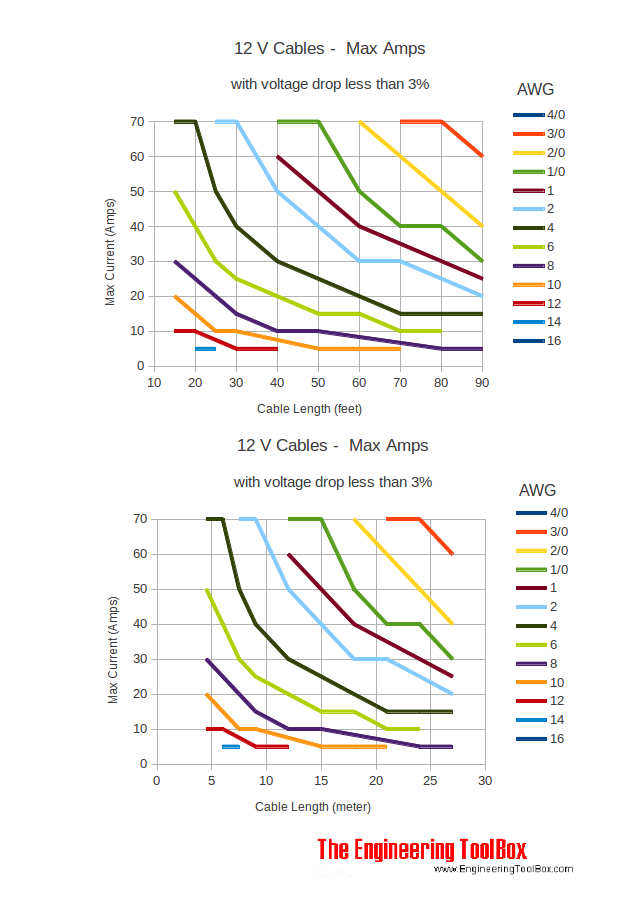
The electrical resistance in a copper conductor with cross sectional area 6 mm 2is 2.9 10 -3 ohm/m. The electrical resistance in a copper conductor with. By increasing the size of the wire to gauge 2 (33.6 mm 2) the maximum length is limited to approximately 32 m. Once you've gathered these two pieces of information, you can enter them into the wire size. Then, you'll need to know the voltage and current that will be flowing through the wire. First, you need to identify the length of the wire you're using. By increasing the size of the wire to gauge #2 (33.6 mm 2) the maximum length is limited to approximately 32 m. From the diagram above the maximum length of the total wire back and forth should not exceed approximately 8 m for gauge 10 (5.26 mm 2). With a few simple steps, you'll be able to find the right wire size for your 12v DC application. The current to a light bulb with power 50 W can be calculated with Ohm's lawįrom the diagram above the maximum length of the total wire back and forth should not exceed approximately 8 m for gauge #10 (5.26 mm 2). How do you calculate wire size The size of an electrical wire means the cross-sectional area it has (and in turn its diameter). double the distance if 4% loss is acceptable 12V wire size calculator Low-voltage lighting wire size calculator and Much more You can even use it instead of a difficult-to-use wire size chart.Maximum lengths for copper conductors from power source to loads in 12 volt systems with 2% voltage drop are indicated below: Wire Length - feetĭownload and print 12 Volt Electric Circuit Chart Wire Length - meterĭownload and print 12 Volt Electric Circuit Chart The electrical resistance in the chassis can normally be neglected and the maximum distance equals the calculated distanceĬross sectional area (mm 2) - AWG Wire Gauge vs. Commonly available in 3mm, 4mm, 6mm and used for most small loads like lighting The number refers to the outside diameter of the cable INCLUDING insulation. in a car where equipment can be grounded to the chassis - the body of the car acts as the negative wire.This should work for most 12-volt devices. The table is based on a 10 loss of voltage on a pair of wires. You just need to know the power in Watts (VA), or Amps and the table will show how far you can go in feet for any size wire pair listed.

The maximum distance between the source and the equipment is half the calculated distance The table below is for 12-volt ac or dc devices only. for a typical electrical circuit with two wires - one back and one forth - this is the length of the two wires together.Using the chart, if you are using a device that requires up to 417mA of power, you can run 18 gauge wire up to 451 feet.The calculator can be used to calculate maximum length of copper wires. For example, if you have a current of 2 Amps and a voltage of 5 Volts, the power calculation is 2A * 5V = 10W. Use the voltage-to-watts conversion tool below if the value you need is not in the chart. Voltage amps/watts can be converted to milli-amps. However, most 24VAC power supplies are measured in voltage amps ("VA"), or watts. The AC voltage cable distance chart works the same way as the DC chart.

For example, if you are using a device that requires a max of 300mA using 18 gauge power cable, it can be run up to 289 feet. Step 1 Calculate the following: VDI (AMPS x FEET)/ (VOLT DROP x VOLTAGE) VDI Voltage Drop Index (a reference number based on resistance of wire) FEET ONE-WAY wiring distance (1 meter 3.28 feet) VOLT DROP Your choice of acceptable voltage drop (example: use 3 for 3) Step 2 Determine appropriate wire size from the chart below. The left column notes the amount of power, in milli-amps, that the device you are powering requires. For example, say you are using a CCTV camera that requires max 300mA. The 'mA' after the number stands for milli-amps. The left column notes the amount of power that the device you are powering requires (red text). What size wire is being used? (18 gauge, 16 gauge, 22 gauge, etc.) Cable size is specified in AWG which stands for "American Wire Gauge". 12V DC Power Drop / Max Cable Distance Chart The below DC voltage drop cable distance chart works as follows. The maximum length that cable can be run for low voltage power varies based on three factors.ĭoes your device require 12 volts DC or 24 volt AC power? Overview Fuses are critical in any electrical system and are used to protect a circuits cabling from excessive current that could lead to damage and, very often, an electrical fire.


 0 kommentar(er)
0 kommentar(er)
